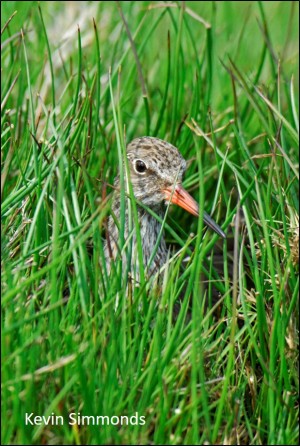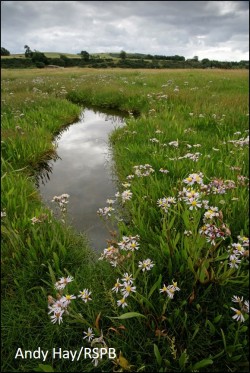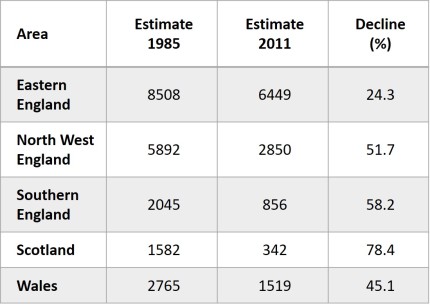 Are subsidies that are designed to protect the biodiversity of Britain’s saltmarshes, delivering the planned, conservation benefits? In particular, is this investment supporting populations of amber-listed Redshank?
Are subsidies that are designed to protect the biodiversity of Britain’s saltmarshes, delivering the planned, conservation benefits? In particular, is this investment supporting populations of amber-listed Redshank?
About 25,000 pairs of Redshank are thought to breed in the United Kingdom (link to APEP), with about half of these nesting in coastal saltmarshes. In recognition of the importance of saltmarshes, agricultural grants are available to support their management, with a focus on providing an appropriate level of grazing for a range of plants, birds and insects. In their 2019 paper in the Journal of Applied Ecology, Lucy Mason and her RSPB colleagues ask some serious questions – are these agricultural subsidies being well spent?
Saltmarsh grazing is an important conservation prescription that is used to try to boost, or at least maintain, populations of breeding waders, particularly Redshank, as well as to conserve the unique herb-rich habitats in which they hide their nests and raise their young. This study follows on from an earlier paper that showed that more than 50% of saltmarsh-nesting Redshank in Great Britain were lost between 1985 and 2011, and three papers by Elwyn Sharps on the impacts of cattle that graze saltmarshes during the Redshank breeding season (about which there is more below).
Why worry about Redshank?
The latest population estimate for Redshank in the United Kingdom is 25,000 pairs, as many as 50% of which are birds nesting on saltings. Redshank is an amber-listed species of conservation concern in the UK, with the most recent population changes showing a drop of 44% between 1995 and 2017 (Breeding Bird Survey) and a larger decline over the period since 1990.

What are saltmarshes?

Rich plant communities
Saltmarshes are intricate, dynamic habitats, where land meets sea. They are highly productive ecosystems, rich in plants, birds and insects. Traditionally, they would have been grazed by herbivorous mammals and waterfowl but, in the absence of free-roaming animals, the only way to maintain the short but diverse swards favoured by specialist plants and animals is to employ the services of cattle and sheep. Although saltmarsh still covers large areas, it is estimated that over 50% has been lost or degraded globally, thanks to reclamation and erosion. Further losses are occurring, as saltmarshes get squeezed between rising sea levels and the hard sea defences that protect coastal settlements and farmland.
The structure of saltmarsh is created by the way that water moves, as waves dissipate their energy and deposit silt during higher, spring and storm tides and the water then runs back off the salting. The latter process creates branching creeks that drain the marsh, from small meandering ditches, that are just big enough to catch a foot and twist an ankle, to waist-deep, fast-flowing channels with slippery, muddy sides.

Deep creeks of outer marsh
Anyone who has been out on a marsh will know that, with some local knowledge, it is possible to make your way from the sea-wall to the edge of the saltmarsh along a route that lies between two creek systems. On the other hand, travelling along the muddy, salting edge parallel to the sea-wall is difficult, as it involves crossing creeks. Grazing animals face the same navigation problems; it’s a lot easier to graze wide expanses of the upper marsh than the outer areas that are dissected by deep creeks. As discussed below, these upper areas, with a mixture of short grass and clumps of longer grass, are also the ones that are favoured by breeding Redshank.
How many Redshank breed on saltmarshes?
A 2013 paper by Lucy Malpas (now Lucy Mason) in Bird Study brought together evidence of declines in saltmarsh-breeding Redshank over a 26-year period. An estimated total of 21,431 pairs were found to be breeding on British saltmarsh in 1985 but this had dropped to 11,946 pairs in 2011, with the highest proportion of the remaining population found in East Anglia. The 2011 survey showed that there were regional variations (see table), with the biggest declines in Scotland. Looking at the way that saltmarshes were managed, Lucy found that Redshank declines were less severe on conservation-managed sites in East Anglia and the South of England, where grazing pressures remained low, but more severe on conservation-managed sites in the North West, where heavy grazing persisted.
 At the end of this Bird Study paper, Lucy and her colleagues suggest that saltmarsh-breeding Redshank declines are likely to be driven by a lack of suitable nesting habitat. Conservation management schemes and site protection, implemented since 1996, appeared not to be delivering the grazing regimes and associated habitat conditions required by this species, particularly in the northwest of England. Although habitat changes may not be linked to unsuitable grazing management in all regions, they suggested the need for a better understanding of grazing practices and consideration of potential long-term management solutions.
At the end of this Bird Study paper, Lucy and her colleagues suggest that saltmarsh-breeding Redshank declines are likely to be driven by a lack of suitable nesting habitat. Conservation management schemes and site protection, implemented since 1996, appeared not to be delivering the grazing regimes and associated habitat conditions required by this species, particularly in the northwest of England. Although habitat changes may not be linked to unsuitable grazing management in all regions, they suggested the need for a better understanding of grazing practices and consideration of potential long-term management solutions.
Grazing levels and Redshank numbers
Intensive grazing leads to a very short uniform sward, lighter grazing produces a more uneven patchy sward with diverse heights, whilst no grazing can leave saltmarshes with dense communities of coarse grasses. For Redshank, that need clumps of grass in which to hide their nests and more open areas in which chicks can feed, light grazing is a key management tool. Elwyn Sharps and colleagues, working on the salt marshes of the Ribble Estuary in northwest England, were interested to see how grazing regimes worked for the local Redshanks. Elwyn showed that the risk of Redshank nest predation increased from 28% with no breeding-season grazing to 95% with grazing of 0.5 cattle per hectare per year, which is still within the definition of light grazing.

In follow-up work, Elwyn showed that livestock play an important role in creating the clumps of Festuca rubra habitat preferred by Redshank nesting on the Ribble Estuary but that even low-intensity conservation grazing can create a shorter than ideal sward height, potentially leaving Redshank nests more vulnerable to predators. There is more about this in the WaderTales blog: Big Foot and the Redshank Nest.

Grazing the higher saltmarsh
One of the missing elements from Elwyn’s first two papers about grazing levels was an understanding of the behaviour of cattle on saltmarsh. In the next piece of work, Elwyn and colleagues tracked the movements of individual cattle, using GPS collars, and assessed the vulnerability of nesting Redshank, using dummy nests. In a 2017 paper in Ecology & Evolution, they showed that cattle spend their time in the same areas of saltmarsh as the ones in which Redshanks like to nest. Their conclusion is that “grazing management should aim to keep livestock away from Redshank nesting habitat between mid-April and mid-July, when nests are active, through delaying the onset of grazing or introducing a rotational grazing system”.
Do conservation payments deliver?
To assess whether conservation grazing is being achieved, and whether agri-environment schemes are effective in delivering this management, Lucy Mason and her colleagues conducted a national survey of English saltmarshes, scoring the management on each site as optimal, suboptimal or detrimental, based on five aspects of grazing (presence, stock type, intensity, timing and habitat impact). They surveyed 213 saltmarsh sites in three regions during 2013, representing 50% of the vegetated saltmarsh in England. Of the study sites, 114 (54%) received payments for saltmarsh management and/or conservation grazing options through Higher Level Stewardship, or the Countryside Stewardship Scheme. The annual cost of saltmarsh and grazing management options in the marshes that were studied was £543,075 for 10,218 ha of saltmarsh, equating to over £5 million spent on saltmarsh management options over the course of 10 years.
 To assess grazing levels, the team visited each site up to four times during the core grazing period (April–October), to count cattle. They also assessed the longer-term impact of grazing on saltmarsh habitat, by measuring sward height and heterogeneity. Combining the measurements of site condition and analysing the results produced the following key findings:
To assess grazing levels, the team visited each site up to four times during the core grazing period (April–October), to count cattle. They also assessed the longer-term impact of grazing on saltmarsh habitat, by measuring sward height and heterogeneity. Combining the measurements of site condition and analysing the results produced the following key findings:
-

Nest hidden in clump of grass
Although most saltmarsh sites in England that are capable of supporting grazing are grazed by livestock, conservation grazing is not being achieved.
- Nationally, the biggest management failings relate to the timing of grazing and the way that grazing impacts upon habitat structure.
- There were regional differences in scores relating to stock type, grazing intensity, grazing timing and habitat impacts, but no single region scored higher than others overall.
- Sites with Agri-Environment Scheme (AES) agreements were no more likely to be grazed than sites without AES – some subsidies were being paid without any active grazing taking place.
- AES reduced grazing pressure but not sufficiently to achieve optimal conservation grazing requirements, indicating that AES has been an ineffective conservation mechanism on saltmarsh.
- In the East, older AES sites scored substantially higher and approached optimal levels, suggesting that managers and advisers can improve outcomes by working together over longer periods.

Improving the system
The authors argue that, although there is sound scientific evidence as to how saltmarshes should be managed, to provide positive conservation outcomes, there are problems when it comes to the translation of evidence into recommendations for hands-on management. It is also difficult to encourage land managers to implement recommendations when these go against traditional farming practices and economic gain. To improve the situation, Lucy and her colleagues suggest that:
- When establishing agreements, it is helpful to provide detailed prescriptions that can guide land-managers.
- AES payments need to take account of the costs of grazing a complex environment, which means thinking about the availability of cattle of appropriate ages at the right times of year, provision of fresh water and high-tide refuges, and the use of fences to divide up the saltmarsh, in order to provide a rotational grazing system.
- Prescriptions that focus on numbers of cattle and timing of grazing are easier to follow than ones that focus on intensity and habitat condition.
- Additionally, a more detailed and reliable system of auditing would be beneficial, to ensure that management activities take place to the necessary standard prior to payments.
- Moving to a results-based scheme, where payments are made based on desirable outcomes, rather than on evidence of management, may improve the overall conservation value and economic efficiency of saltmarsh AES options.
 In conclusion
In conclusion
Raising cattle on saltmarsh is hard work, in terms of stock control, but requires no fertiliser inputs. These ‘mobile mowing units’ stop saltings from becoming long and rank, thereby creating spaces in which a rich plant and grass community can flourish, where geese and waterfowl can graze during the winter months, and potentially providing nesting spaces for breeding waders, such as the amber-listed Redshank, breeding numbers of which are still declining.
Lucy and her RSPB colleagues conclude that Agri-environment Schemes are the only mechanisms through which saltmarsh conservation grazing can be implemented on a national scale, so it’s important to make sure that they are as effective as possible. By working together, it is hoped that policymakers, researchers and managers can refine conservation guidelines which are used to create management schemes that attract subsidies. They suggest that better value could be achieved through more sensitive use of current management activities or perhaps by linking payments to conservation outcomes, rather than on evidence of management.
 The noisy warning calls of a pair Redshank, as they encourage their chicks to hide, have earned the species the title ‘warden of the marshes’. Their calls also appear to be a warning cry about the state of Britain’s saltmarshes, despite the large amount of money being provided through agricultural subsidies and the good intentions of conservation organisations, agricultural advisers and graziers.
The noisy warning calls of a pair Redshank, as they encourage their chicks to hide, have earned the species the title ‘warden of the marshes’. Their calls also appear to be a warning cry about the state of Britain’s saltmarshes, despite the large amount of money being provided through agricultural subsidies and the good intentions of conservation organisations, agricultural advisers and graziers.
You can read more here:
Are agri-environment schemes successful in delivering conservation grazing management on saltmarsh? Lucy R. Mason, Alastair Feather, Nick Godden, Chris C. Vreugdenhil & Jennifer Smart. Journal of Applied Ecology. May 2019.

WaderTales blogs are written by Graham Appleton, to celebrate waders and wader research. Many of the articles are based on previously published papers, with the aim of making wader science available to a broader audience.

Reblogged this on Wolf's Birding and Bonsai Blog.
LikeLike
Pingback: Managing water for waders | wadertales
Pingback: January to June 2019 | wadertales
Very interesting, thanks for compiling that. Any work done on the impact of other salt marsh grazers such as ponies or sheep?
LikeLike
Thank you for the kind comment. There are some references to sheep grazing in Elwyn Sharps’ thesis but the only papers I have read are about cattle: https://pdfs.semanticscholar.org/4e1c/15c201d460ac68e4c673f84ff7a3fc683ea9.pdf
LikeLike
Pingback: Fennoscandian wader factory | wadertales
Pingback: WaderTales blogs in 2019 | wadertales
Pingback: Wales: a special place for waders | wadertales
Pingback: Waders on the coast | wadertales
Pingback: Remote monitoring of wader habitats | wadertales
Thanks Graham for writing this excellent piece. I surveyed large areas of the Essex saltmarshes on 1995 for the RSPB to determine redshank populations and saltmarsh habitats. Much of the marsh area was ungrazed ‘mid-marsh’, with puccinelia (saltmarsh grass) and sea purslane dominant that produced good structural heterogenity. Redshanks often reached quite high densities here but the rising sea levels have gradually pushed this plant community back up into the sea wall. Thus redshanks have markedly declined due to high Spring tides and increased predation on some marshes that I know well, foxes, crows and badgers.
The marshes that lie out from Bradwell Bird Observatory in Essex have lost almost all their breeding redshanks now, there were about 30 PRS in 1995.
This research highlights well the benefits of grazing the upper salt marshes lightly at the right time of year. I was shocked at the habitat uniformity of some of the overgrazed marshes in the Ribble, though I don’t really know that area well. I also believe that heavy cattle grazing could also increase saltmarsh erosion.
Let’s hope that this excellent work leads to changes in grazing regimes as currently it seems disasterous for redshank nesting success.
LikeLike
Thank you for your interesting observations.
LikeLike
Pingback: WaderTales: a taste of Scotland | wadertales